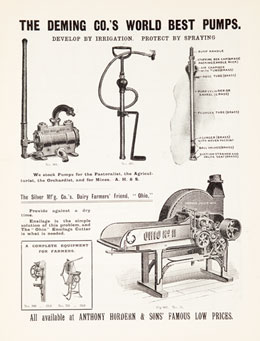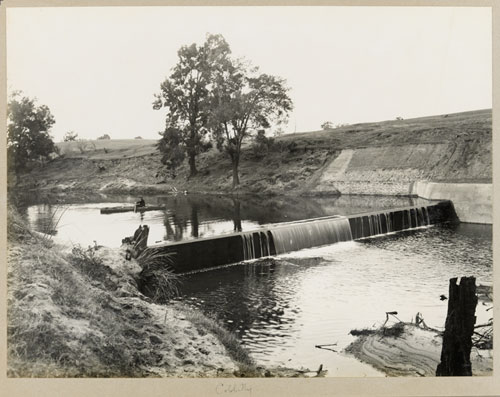Water management
Managing scarce water resources has always been a priority for Australia’s farmers and graziers. Crops and animals are dependent on water for their survival and harnessing the natural water resources found in rivers and creeks is a vital part of successful agriculture. Before large scale irrigation systems were developed, sharing water resources sometimes led to conflict between farming neighbours. Rivers which flowed through several properties might be pumped or dammed to water stock and crops by landholders upstream. This substantially reduced the water flow downstream, leaving those farmers with fewer resources, especially in times of drought.

The Deming Co.'s Worlds Best Pumps [advertisement] from The Australian settler's complete guide : scientific and practical by Robt. Kaleski ; with legal chapter by Thos. Rose. Sydney : Anthony Hordern and Sons, 1910. Printed book 630.2/K
Although many farmers set up their own irrigation systems and water management practices, at the turn of the 20th century, the New South Wales government stepped in to manage the water resources of the Murrumbidgee and Murray Rivers, laying the groundwork for the first large-scale irrigation systems in Australia. The first project to be commsisoned was the Burrinjuck Dam in 1906. Its purpose was to dam the waters near the mouth of the Murrumbidgee and supply the adjacent farmland areas with water via gravity feed. In the next few years a complex system of canals were developed giving rise to irrigated blocks of land which were quickly settled by dairy and rice farmers and horticulturalists.
Work continued on the Murrumbidgee scheme, which eventually encompassed the iconic Snowy Mountains Hydroelectric Scheme, into the 1970s. The whole scheme is considered a major engineering feat and gave rise to several towns which were purpose built to accommodate workers on the scheme, including Leeton and Griffith.
> View photographs of the Murrumbidgee irrigation Scheme in development, 1912-1913
The Murray River Irrigation scheme was a bit more controversial. It was first proposed at the end of the 19th century but South Australia was concerned that the NSW irrigation system would extract most of the water from the Murray before it flowed across the border, threatening their thriving riverboat trade. The arguments between the two States over water resources even threatened Federation in 1901. It took a three year drought to finally convince the Commonwealth Government to sign off on the Muray irrigation system in 1915, and the first big building project was the Hume Dam in 1919.
Both the Murrumbidgee and the Murray irrigation systems are now run by private companies. They supply water to over a million hectares of farmland as well as providing town water to towns as large as Deniliquin. The Riverina area is now considered one of Australia’s most productive and successful regional areas.
Across the country throughout the twentieth century, dams and reservoirs were constructed on various scales to preserve and manage water resources for town and country use. Almost every country town has a local reservoir, which now double as beauty and recreation spots.

Cobbitty from Country towns water supply, 1909-1928. Photograph from album PXE 842 /14


